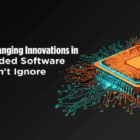Selecting the right embedded operating system (OS) is a critical decision that impacts the functionality, security, and efficiency of embedded projects. With applications ranging from IoT devices to complex industrial automation systems, an embedded OS needs to meet specific requirements tailored to your project’s demands. As embedded systems continue to gain prominence—reaching an estimated global market size of $102 billion in 2024 (MarketWatch)—understanding the essential selection factors has never been more important.
Here’s a breakdown of five essential steps to help guide you in choosing the right embedded OS, along with insights on how Evolute is advancing embedded technology.
1. Define Your Device’s Purpose: “Know the Needs Before You Lead.”
The first and most crucial step is to clearly outline your device’s purpose and the specific demands it places on the operating system. For instance, real-time applications like medical devices or automotive systems require Real-Time Operating Systems (RTOS), which prioritize low latency and reliable task scheduling. In contrast, consumer IoT devices may favor a general-purpose OS with robust connectivity options.
A 2024 survey by Embedded World revealed that over 60% of developers prioritize the specific application requirements when selecting an OS, as these requirements directly influence the device’s responsiveness, security, and user experience. At Evolute, we understand the importance of aligning system functions with project objectives, ensuring that every product meets its performance goals through precise OS selection.
Key Considerations:
- Does your device require real-time processing?
- Will it operate in a connected environment or standalone?
- Are security and reliability crucial?
2. Evaluate Hardware Compatibility: “Power, Process, and Pairing”
Not all embedded operating systems work seamlessly with every hardware configuration. Ensuring compatibility between the OS and your hardware is essential for optimal performance and longevity. Whether you’re using microcontrollers (MCUs) or more advanced microprocessors (MPUs), certain OS options may be better suited to your hardware architecture.
According to a report by Electronics Weekly in 2024, 68% of embedded systems failures were attributed to OS and hardware mismatches, underlining the importance of careful compatibility checks. Compatibility goes beyond simple matching; it also impacts power efficiency, memory usage, and computational resources, which are all crucial for embedded systems.
Key Considerations:
- What processor architecture are you using (ARM, RISC-V, x86)?
- Is the OS optimized for your chosen hardware to ensure energy efficiency?
- Can the OS efficiently utilize the memory and processing power available?
3. Analyze Security Needs: “Fortify the Framework”
Security is a growing concern in embedded systems, especially as IoT and connected devices become more widespread. By 2024, the frequency of security breaches in IoT devices has led to a 25% increase in the adoption of secure OS options, according to Cybersecurity Ventures. When selecting an embedded OS, it’s essential to look for features like secure boot, encrypted data transmission, and regular firmware updates.
In line with this, Evolute prioritizes security across its products, implementing embedded solutions with built-in security features to safeguard against data breaches and unauthorized access.
Key Considerations:
- Does the OS support secure boot to prevent unauthorized code execution?
- Are there options for data encryption and user authentication?
- How regularly does the OS receive security patches and updates?
4. Check for Scalability: “Plan for Growth, Stay Agile”
Scalability is critical in embedded systems, especially for devices that may need to evolve with added features, enhanced processing power, or expanded memory. In 2024, a report by Embedded Computing found that 45% of organizations sought scalable OS solutions that could accommodate future updates without needing a complete overhaul of the device.
Embedded OS choices like Linux-based distributions and certain RTOS options offer modular architectures that allow developers to easily scale or upgrade their systems. This flexibility is invaluable in fields such as industrial automation or smart home technology, where products may need to adapt to new software updates or additional sensors.
Key Considerations:
- Does the OS offer modularity to facilitate easy upgrades?
- How well can the OS support additional components or features?
- Will it require extensive recording to implement future changes?
5. Consider Support, Community, and Cost: “Seek the Source of Support.”
The availability of robust documentation, community support, and cost considerations all play significant roles in embedded OS selection. Open-source operating systems, like FreeRTOS and Embedded Linux, are widely adopted due to their cost-effectiveness and large developer communities that provide resources, troubleshooting tips, and enhancements.
However, some industries, such as healthcare and automotive, require stringent regulatory compliance, which can sometimes make commercial OS solutions more appealing due to the vendor support they offer. Research in 2024 by the Embedded Systems Association highlights that 78% of developers prefer OS options with established support channels, as this minimizes development time and helps address issues swiftly.
Evolute stays connected to these developments, leveraging OS platforms with robust support for accelerated problem resolution, whether through open-source channels or commercial partnerships.
Key Considerations:
- Is the OS open-source or commercial, and does it fit your budget?
- Are there adequate support channels, including community forums or vendor support?
- What is the cost of licensing, and does it meet project budget constraints?
Evolute’s Approach to Embedded Excellence
At Evolute, our commitment to advanced embedded solutions includes selecting and utilizing operating systems that optimize functionality, security, and scalability. By staying at the cutting edge of OS compatibility, we deliver embedded products that meet the exact needs of each client and project. Evolute’s embedded solutions are designed with modularity, efficiency, and security at their core, ensuring they meet today’s demanding technological standards.
Essential Takeaways for Choosing the Right Embedded OS
When selecting an embedded operating system, a structured approach ensures that the final choice aligns perfectly with project requirements and goals. Here’s a quick summary:
- Know Your Needs: Define the device’s purpose to choose an OS that aligns with project demands.
- Ensure hardware compatibility: Confirm that the OS works with your hardware configuration for optimal efficiency.
- Prioritize Security: Look for secure boot, encryption, and regular updates to protect the system.
- Plan for Scalability: Choose an OS that supports future growth without requiring significant modifications.
- Factor in Support and Cost: Evaluate the available support, community resources, and overall cost-effectiveness.
With these steps, developers can select an embedded operating system that not only meets current needs but also provides room for future expansion and improvement. As Bill Gates said, “Technology is just a tool,” and choosing the right OS is about selecting the tool that best serves your project’s purpose and potential.





